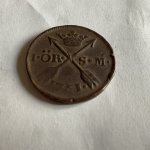ShipwreckHunter
Jr. Member
- May 15, 2015
- 38
- 137
- Detector(s) used
-
Garrett Master Hunter
GTI 2500
Infinium LS
Sea Hunter II
Pro-Pointer AT
- Primary Interest:
- Shipwrecks
How the "Mistake" found a shipwreck that caused a doubling of the size of the United
Fisherman Jerry Murphy and his crew of the "Mistake" snagged something unexpected while trawling the Gulf of Mexico one afternoon in 1993. At first glance, the fishing net appeared weighted down with rock and debris. Upon closer inspection, some of those rocks were actually piles of silver coins, which had fused together while underwater. Realizing that he may have stumbled onto a deep sea treasure trove, Murphy dialed up his lawyer to attain rights to the booty, then contacted maritime history experts to determine the source of the coins. A year later, researchers concluded that Murphy's discovery -- which occurred, ironically, in a boat named Mistake -- was the ruins of a warship called El Cazador, or "The Hunter," that disappeared at sea in 1784.
The lost treasure ship whose sinking in 1784 played a minor role in the early history of the United States has been discovered in 300 feet of water about 50 miles off Louisiana and part of the cargo was recovered. The vessel, El Cazador, or the Hunter, had been sent by Spain from its port in New Orleans to pick up Mexican coins for its holdings in Louisiana, with the aim of stabilizing their currency. The ship's manifest listed 450,000 pesos. She left Veracruz, Mexico, on Jan. 11, 1784, but never arrived back in New Orleans. The ship was eventually declared lost. As the Louisiana holdings failed to pick up economically, they were ceded by Spain in 1800 back to France, which sold them in 1803 to the United States as the Louisiana Purchase, doubling the size of the young republic. The lost ship, an armed vessel called a brigantine of war, was about 90 feet long, with a shallow draft and two masts. The wreckage was discovered by accident in August 1993, when a fishing vessel snagged its net on an underwater obstruction. The raised net dropped hundreds of coins onto the fishing vessel's deck, all of them minted in Mexico City and most of them dated 1783. The fishing vessel's owner, Jim Reahard of Grand Bay, Ala., who sails out of Pascagoula, Miss., approached an admiralty lawyer in Key West, Fla., David Paul Horan, who then filed a claim on the wreck for Mr. Reahard. An underwater salvage concern, Marex International Inc. of Memphis, was hired to explore the site. In September, Marex used a sonar and a small underwater robot to find the wreck. "It took only one hour to locate the target and then three days to properly photograph it with underwater video," Marex said in a statement. "Coins could be seen covering the wreck site."
A Deal is Made ...
Napoleon dreamed of creating a Western empire centered on international trade. The French Caribbean islands and Hispaniola (Haiti and the Dominican Republic) could farm sugar, coffee and tropical produce. With New Orleans as its trading stronghold in North America, Napoleon would wield economic power over the United States . However, a slave uprising led by Toussaint L'Ouverture in Saint-Domingue (the former name for Haiti) dashed those imperial plans.
The only successful slave revolt in history, French forces couldn't quell the Haitian rebellion. Napoleon dispatched 20,000 soldiers to restore peace and order, but a combination of yellow fever and unyielding solidarity among the former slaves defeated the military's efforts. By late 1802, France had lost an estimated 55,000 men. Since Saint Domingue was France's most lucrative colony in the West, Napoleon considered it a key asset for building his Caribbean empire. Cutting his losses, Napoleon abandoned the Western strategy and decided to refill France's dwindling treasury for impending war with Britain.
While Napoleon sorted out his imperial problems, another legendary leader also contemplated expanding his nation's horizons. President Thomas Jefferson viewed French control over the port at New Orleans as a hindrance to American settlement in the West. Jefferson didn't want to fight with France over the territory, instead seeking a diplomatic solution. He sent James Monroe as his envoy to the French government with an offer to buy New Orleans for no more than $3 million.
Instead of haggling over the port city, Napoleon surprised Jefferson by upping the ante. He put up the entire Louisiana Territory for sale -- no more, no less. The strict constructionist president was conflicted at first with the offer since the Constitution didn't include allowances for the federal government to accept land purchases. To get around that, he framed the deal as a treaty between the United States and France. The strategy worked, and Jefferson bought the enormous swath of land between the Mississippi River and the Rocky Mountains for $15 million on April 30, 1803.
Priced at barely four cents per acres, the 828,000 square miles (2.1 million square kilometers) signed over in Jefferson's Louisiana Purchase Treaty effectively doubled the size of the country. In less than three years, Louisiana passed from Spain to France to the United States. Though it took an unlikely shipwreck, a war, and a slave uprising to get there, Jefferson sealed the largest land deal in U.S. history with peaceful diplomacy and a signature. Don't forget, if you like stories of shipwrecks and lost treasure.. please visit and like my Facebook page at: https://www.facebook.com/Shipwreckhunter
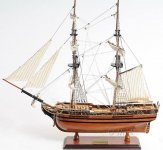
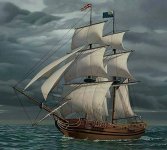
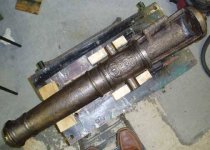
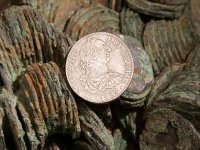
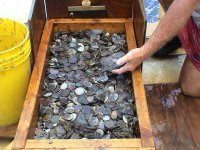
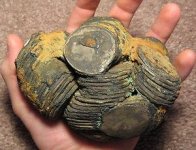

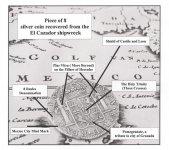
Fisherman Jerry Murphy and his crew of the "Mistake" snagged something unexpected while trawling the Gulf of Mexico one afternoon in 1993. At first glance, the fishing net appeared weighted down with rock and debris. Upon closer inspection, some of those rocks were actually piles of silver coins, which had fused together while underwater. Realizing that he may have stumbled onto a deep sea treasure trove, Murphy dialed up his lawyer to attain rights to the booty, then contacted maritime history experts to determine the source of the coins. A year later, researchers concluded that Murphy's discovery -- which occurred, ironically, in a boat named Mistake -- was the ruins of a warship called El Cazador, or "The Hunter," that disappeared at sea in 1784.
The lost treasure ship whose sinking in 1784 played a minor role in the early history of the United States has been discovered in 300 feet of water about 50 miles off Louisiana and part of the cargo was recovered. The vessel, El Cazador, or the Hunter, had been sent by Spain from its port in New Orleans to pick up Mexican coins for its holdings in Louisiana, with the aim of stabilizing their currency. The ship's manifest listed 450,000 pesos. She left Veracruz, Mexico, on Jan. 11, 1784, but never arrived back in New Orleans. The ship was eventually declared lost. As the Louisiana holdings failed to pick up economically, they were ceded by Spain in 1800 back to France, which sold them in 1803 to the United States as the Louisiana Purchase, doubling the size of the young republic. The lost ship, an armed vessel called a brigantine of war, was about 90 feet long, with a shallow draft and two masts. The wreckage was discovered by accident in August 1993, when a fishing vessel snagged its net on an underwater obstruction. The raised net dropped hundreds of coins onto the fishing vessel's deck, all of them minted in Mexico City and most of them dated 1783. The fishing vessel's owner, Jim Reahard of Grand Bay, Ala., who sails out of Pascagoula, Miss., approached an admiralty lawyer in Key West, Fla., David Paul Horan, who then filed a claim on the wreck for Mr. Reahard. An underwater salvage concern, Marex International Inc. of Memphis, was hired to explore the site. In September, Marex used a sonar and a small underwater robot to find the wreck. "It took only one hour to locate the target and then three days to properly photograph it with underwater video," Marex said in a statement. "Coins could be seen covering the wreck site."
A Deal is Made ...
Napoleon dreamed of creating a Western empire centered on international trade. The French Caribbean islands and Hispaniola (Haiti and the Dominican Republic) could farm sugar, coffee and tropical produce. With New Orleans as its trading stronghold in North America, Napoleon would wield economic power over the United States . However, a slave uprising led by Toussaint L'Ouverture in Saint-Domingue (the former name for Haiti) dashed those imperial plans.
The only successful slave revolt in history, French forces couldn't quell the Haitian rebellion. Napoleon dispatched 20,000 soldiers to restore peace and order, but a combination of yellow fever and unyielding solidarity among the former slaves defeated the military's efforts. By late 1802, France had lost an estimated 55,000 men. Since Saint Domingue was France's most lucrative colony in the West, Napoleon considered it a key asset for building his Caribbean empire. Cutting his losses, Napoleon abandoned the Western strategy and decided to refill France's dwindling treasury for impending war with Britain.
While Napoleon sorted out his imperial problems, another legendary leader also contemplated expanding his nation's horizons. President Thomas Jefferson viewed French control over the port at New Orleans as a hindrance to American settlement in the West. Jefferson didn't want to fight with France over the territory, instead seeking a diplomatic solution. He sent James Monroe as his envoy to the French government with an offer to buy New Orleans for no more than $3 million.
Instead of haggling over the port city, Napoleon surprised Jefferson by upping the ante. He put up the entire Louisiana Territory for sale -- no more, no less. The strict constructionist president was conflicted at first with the offer since the Constitution didn't include allowances for the federal government to accept land purchases. To get around that, he framed the deal as a treaty between the United States and France. The strategy worked, and Jefferson bought the enormous swath of land between the Mississippi River and the Rocky Mountains for $15 million on April 30, 1803.
Priced at barely four cents per acres, the 828,000 square miles (2.1 million square kilometers) signed over in Jefferson's Louisiana Purchase Treaty effectively doubled the size of the country. In less than three years, Louisiana passed from Spain to France to the United States. Though it took an unlikely shipwreck, a war, and a slave uprising to get there, Jefferson sealed the largest land deal in U.S. history with peaceful diplomacy and a signature. Don't forget, if you like stories of shipwrecks and lost treasure.. please visit and like my Facebook page at: https://www.facebook.com/Shipwreckhunter








Amazon Forum Fav 👍
Last edited:




